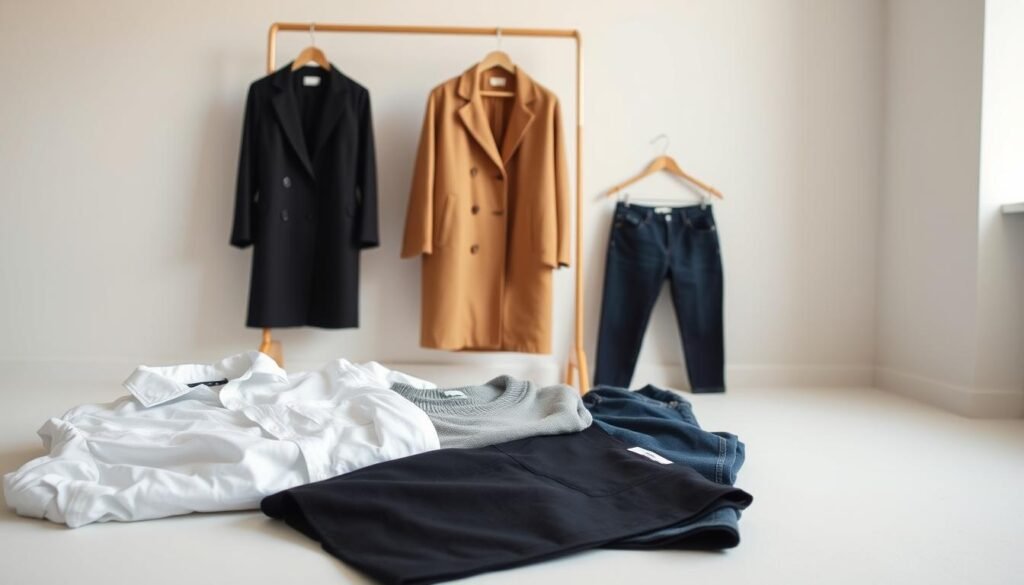Have you ever stood in front of a closet full of clothes and still felt like you had nothing to wear? I’ve been there. The chaos of endless options often leaves us overwhelmed, not empowered. That’s where capsule wardrobe essentials come in—a curated collection of just 10 versatile pieces designed to simplify your life while keeping you effortlessly stylish.
Imagine waking up to a closet filled only with items you love. Brands like Everlane and Loulou Studio prove that timeless staples—think cashmere sweaters, crisp white tees, and perfectly tailored jeans—never go out of style. These pieces aren’t just clothes; they’re investments in a clutter-free routine and a more sustainable future.
Minimalist fashion isn’t about sacrifice. It’s about choosing quality over quantity. With brands like Toteme and COS leading the way, building a functional wardrobe becomes easier. You’ll spend less time deciding what to wear and more time living in clothes that make you feel confident.
Embracing the Capsule Wardrobe Concept
Streamlining your style isn’t about less—it’s about intentionality. The idea of curating a small collection of versatile garments has surged in popularity, driven by a cultural shift toward mindful consumption. Brands like COS and Toteme champion this philosophy, offering structured blazers and tailored trousers designed to transcend fleeting trends.
Why does a minimalist approach work? By focusing on high-quality pieces, you eliminate the frustration of mismatched outfits. A study by The Wall Street Journal found that individuals who pared down their closets reported a 40% reduction in morning decision fatigue. As one sustainability advocate noted:
“Owning fewer, better-made items isn’t restrictive—it’s liberating.”
Consider the practical advantages:
| Category | Traditional Wardrobe | 10-Item Approach |
|---|---|---|
| Average Items | 85+ | 10 |
| Weekly Outfit Combinations | 15-20 | 25+ |
| Annual Clothing Waste | 70 lbs | Under 10 lbs |
This strategy isn’t just personal—it’s planetary. Fast fashion contributes to 10% of global carbon emissions, but opting for durable materials like organic cotton or recycled polyester slashes your environmental footprint. Loulou Studio’s seasonless dresses exemplify this, transitioning seamlessly from office meetings to weekend brunches.
Your curated selection becomes a toolkit for self-expression. A crisp white shirt pairs with dark denim for casual Fridays, then layers under a wool blazer for client presentations. It’s fashion stripped down to its most purposeful—and powerful—form.
Understanding What a Capsule Wardrobe Is

What if your morning routine involved zero outfit dilemmas? This question sparked a revolution in fashion decades ago. British designer Susie Faux first introduced the concept in the 1970s, defining it as a curated set of interchangeable items that maximize outfit potential. Her London boutique, “Wardrobe”, became ground zero for practical elegance.
The History Behind Capsule Wardrobes
Donna Karan’s 1985 “Seven Easy Pieces” collection transformed Faux’s idea into mainstream culture. Her system used layering essentials like bodysuits and tailored skirts to create 50+ looks. This approach proved that strategic planning beats endless shopping sprees.
Modern iterations focus on three pillars:
- Neutral colors (black, white, beige) as anchors
- Durable fabrics for year-round wear
- Items like dark-wash jeans that pair with everything
Defining Your Minimalist Approach
Your version should reflect daily needs. Start by choosing 2-3 base colors that complement your skin tone. A cream sweater or charcoal trousers becomes the canvas for bolder accents. Classic blue jeans offer unmatched flexibility—dress them up with loafers or down with sneakers.
As Faux famously advised:
“Edit ruthlessly. Keep only what makes you feel unstoppable.”
This philosophy isn’t about strict rules. It’s about designing a closet that adapts to your life—whether you’re chasing deadlines or weekend adventures.
Benefits of Downsizing Your Closet
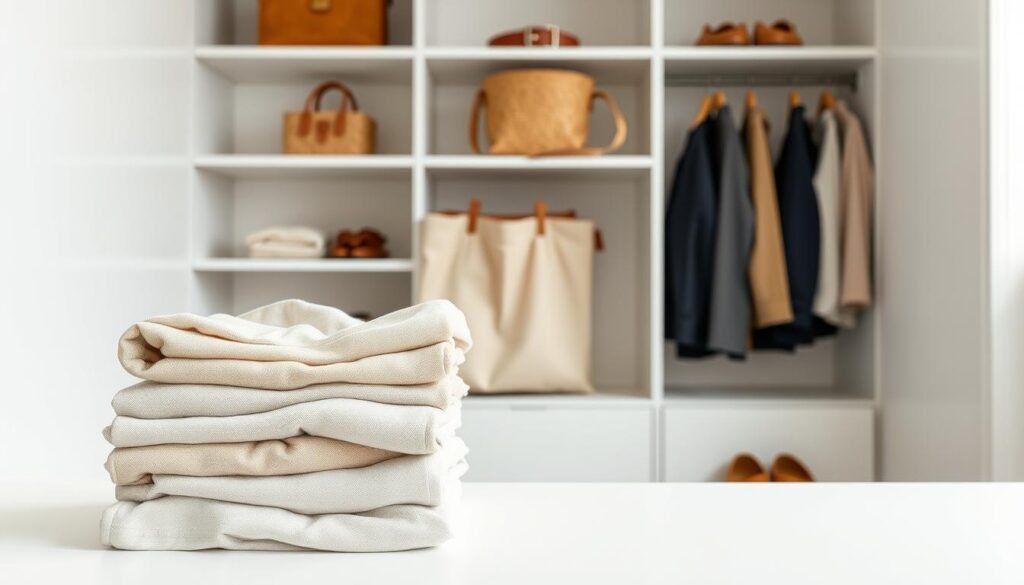
How much time do you waste sifting through clothes you never wear? Downsizing your collection unlocks surprising advantages—from sharper daily focus to meaningful environmental impact. Let’s explore how simplifying your closet reshapes both your routine and your relationship with fashion.
Reducing Decision Fatigue
A 2018 University of Pennsylvania study found people make 35,000+ daily choices—with what to wear ranking among the most draining. By limiting options to 10-15 versatile pieces, you conserve mental energy for bigger priorities. As psychologist Dr. Barry Schwartz notes:
“Choice overload paralyzes us. Curated simplicity lets confidence take center stage.”
This approach also streamlines laundry cycles and storage needs. You’ll spend 72% less time organizing seasonal items according to Real Simple magazine.
Achieving Sustainable Fashion
The average American discards 81 pounds of clothing yearly. Transitioning to a smaller closet slashes textile waste by 85% while encouraging mindful purchases. Brands like Patagonia and Eileen Fisher now offer repair programs for worn items—proving sustainability pairs perfectly with style.
Consider these impacts:
- Each quality piece replaces 30 fast-fashion purchases over its lifespan
- Organic cotton uses 91% less water than conventional alternatives
- Secondhand markets grew 24% last year as shoppers prioritize reuse
Your streamlined outfits become a personal manifesto—one that values craftsmanship over trends. Explore our guides on eco-friendly fabrics and closet audits to deepen this practice.
Capsule Wardrobe Essentials: Your Minimalist Must-Haves

What separates a functional closet from a chaotic one? The answer lies in selecting pieces that work harder than you do. Start with a tailored jacket—Everlane’s wool-blend blazer effortlessly transitions from office presentations to weekend errands. Pair it with Loulou Studio’s cloud-soft cashmere sweater for warmth that never sacrifices style.
Your daily uniform thrives on simplicity. A crisp white tee becomes the backbone of countless outfits, while dark-wash jeans from brands like Madewell offer durability without compromising comfort. These items form a neutral foundation, allowing accessories or bold shoes to shine.
Investing time upfront pays off. As one Everlane designer notes:
“Every stitch should solve a problem.”
For example, their high-rise trousers pair with sneakers for brunch or heels for evenings—no wardrobe swaps needed.
Prioritize pieces that defy seasons. A leather tote carries laptops and groceries alike, while ankle boots blend practicality with polish. Each item should pair with at least three others, multiplying outfit options without clutter.
Time spent curating these staples isn’t just about today’s look—it’s about building a system that adapts to your life. When every jacket, top, and bottom aligns with your rhythm, getting dressed becomes a celebration of ease, not exhaustion.
Creating Your 10-Item Wardrobe

Building a versatile closet starts with ruthless editing. Begin by emptying your storage and laying every piece on your bed. Ask: “Have I worn this in the past year?” If not, donate or recycle it. This step alone eliminates 60% of clutter, according to professional organizers.
Focus on year-round adaptability. For pants, choose two styles: tailored trousers for formal settings and dark-wash jeans for casual days. Madewell’s high-rise denim works with blazers and sneakers alike, lasting years without fading. Avoid trendy cuts—straight-leg designs remain relevant across seasons.
Shoes anchor your look. Invest in neutral loafers and sleek ankle boots. A designer at Everlane explains:
“Great footwear should survive three years of daily wear while elevating simple outfits.”
Follow this selection framework:
- Pick 3 tops (e.g., white tee, striped sweater, silk blouse)
- Add 2 pants (dark jeans, black trousers)
- Include 1 dress or jumpsuit
- Choose 2 outer layers (blazer, trench coat)
- Select 2 shoes (loafers, boots)
Test each item’s versatility. Can those black trousers pair with sneakers for errands and heels for dinners? Does your sweater layer under a coat? For deeper strategies, explore our guide on curating long-lasting outfits.
Prioritize fabrics that withstand years of washing—organic cotton, merino wool, and recycled polyester. This approach transforms your closet into a precision toolkit, ready for any event without excess.
Building a Timeless Wardrobe Foundation
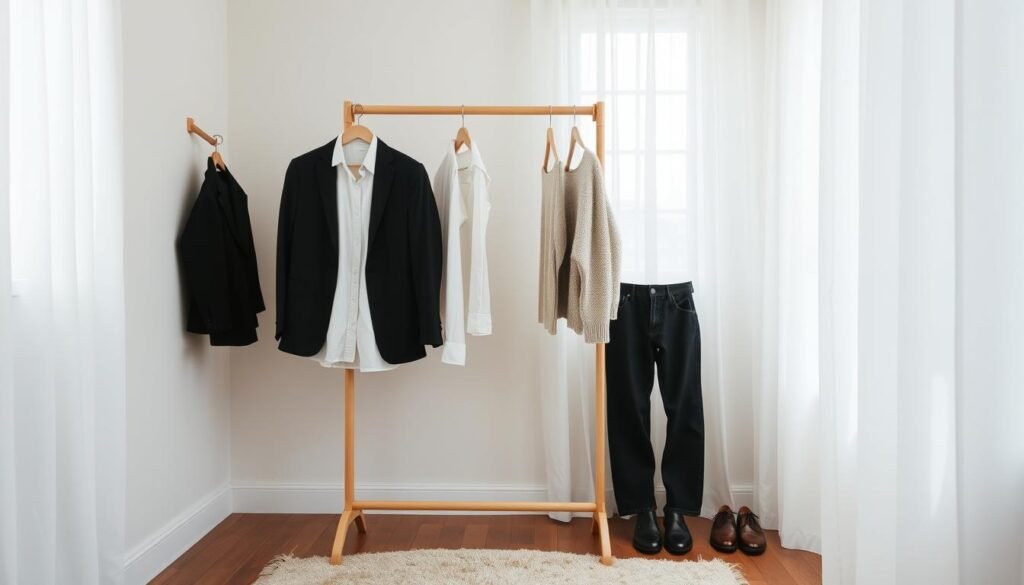
Why do some outfits remain stylish decade after decade? The secret lies in pieces that transcend temporary fads. A timeless foundation ensures every look feels intentional, whether you’re dressing for meetings or weekend outings. It’s not about chasing trends—it’s about mastering the art of strategic simplicity.
Investing in High-Quality Pieces
Quality fabrics and craftsmanship determine how your clothes age. A study by Vogue Business found garments made from organic cotton or merino wool last 3x longer than fast-fashion alternatives. For example, Toteme’s double-faced wool coat works as well with summer dresses as winter layers—proving versatility beats seasonality.
“A well-made dress isn’t just clothing—it’s armor for daily life,” says Toteme’s creative director.
Compare these options:
| Item Type | Average Lifespan | Cost Per Wear |
|---|---|---|
| Fast-Fashion Blouse | 6 months | $1.20 |
| Tailored Silk Shirt | 5+ years | $0.18 |
Linking to Expert Fashion Guides
Discover how to identify enduring styles through resources like our Sustainable Fabric Guide or Year-Round Layering Handbook. These tools help you build looks that adapt to any season without compromising your aesthetic.
Focus on items serving multiple purposes. A midi dress in neutral tones transitions from office wear to evening events with a jacket swap. By choosing this way, you’ll craft outfits that feel fresh yet familiar—no matter the year or weather.
Choosing the Right Colors and Pieces for Versatility
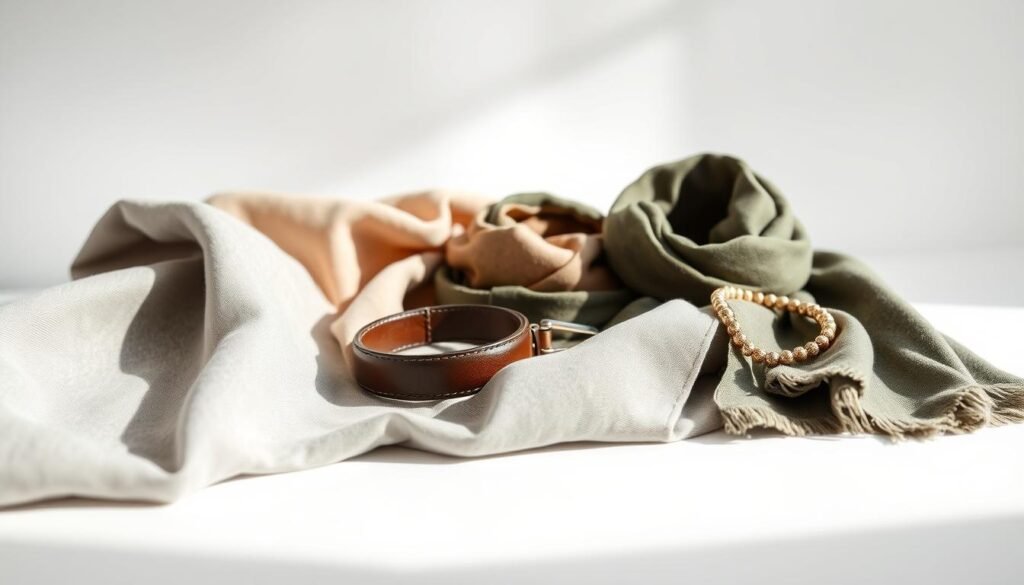
Color transforms basic items into endless possibilities. Your building capsule wardrobe thrives when 80% of pieces use neutral tones like ivory, charcoal, or camel. These act as blank canvases, letting bold accents shine without clashing. As stylist Jessica Nguyen advises: “Three base colors create cohesion—your fifth outfit looks as intentional as your first.”
Mixing Neutrals with Accent Colors
Add personality with strategic pops of color. A ruby-red cardigan elevates gray trousers, while mustard-yellow sneakers energize monochrome outfits. Brands like Everlane use this formula—their “Cloud” collection pairs sand-colored tees with seafoam-green jackets for subtle contrast.
Balance is key. Follow this framework:
| Neutral Base | Accent Color | Brand Example |
|---|---|---|
| Oatmeal | Terracotta | Madewell |
| Navy | Blush Pink | Quince |
| Black | Emerald Green | Reformation |
Casual items anchor your palette. White leather sneakers from Cariuma pair equally with charcoal suits and olive joggers. This flexibility lets you create 12+ looks without new purchases.
Explore our color theory guide to refine your building capsule strategy. Remember: Neutrals build trust in your closet’s reliability—accents keep it exciting.
Utilizing Denim, Leather, and More as Statement Pieces
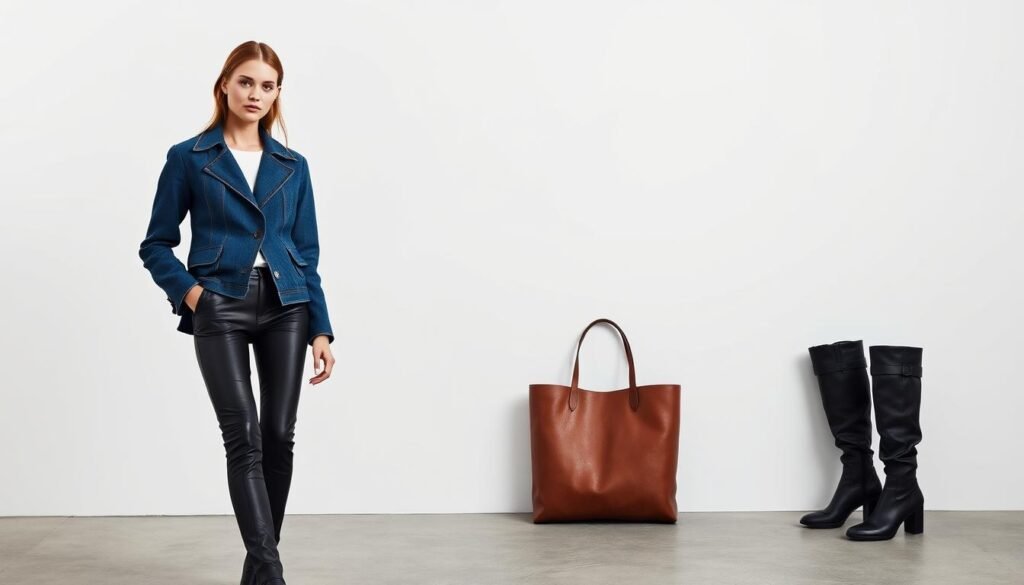
Statement pieces define your style identity while anchoring daily looks. Denim and leather transcend trends, offering unmatched adaptability across settings. Brands like Gucci showcase this with vintage-inspired jeans that work equally with silk blouses or graphic tees. Khaite’s buttery-soft moto jackets prove leather isn’t just edgy—it’s office-ready when layered over midi dresses.
Mix and Match: Casual and Chic Combinations
Transform basics with strategic pairings. Dark denim elevates a white button-down for client meetings, then swaps with cropped sweaters for weekend errands. As Khaite’s creative director notes:
“Leather adds instant polish. A tailored jacket pairs with joggers for relaxed Fridays or sheath dresses for evening cocktails.”
Build versatile outfits using this framework:
| Item | Day Look | Night Look |
|---|---|---|
| Black Leather Pants | Oversized sweater + loafers | Sequined top + stilettos |
| Distressed Jeans | Blazer + ankle boots | Crop top + heeled mules |
Invest in high-waisted jeans with clean finishes—AGOLDE’s 90s styles work with both sneakers and blazers. For leather, choose neutral tones like espresso brown or charcoal. These hues blend seamlessly into existing collections while making bold impressions.
Explore our detailed styling guides to master transitional outfits. With three core denim and leather pairs, you’ll craft 20+ looks that feel fresh yet intentional. It’s about designing a signature aesthetic—one that thrives on reinvention, not excess.
Strategies for Effective Interlinking to Enhance SEO

Ever clicked through a blog only to find dead ends? Strategic internal linking acts like a roadmap, guiding readers to related content while boosting your site’s authority. Search engines prioritize pages with strong connections, as they signal comprehensive coverage of topics like denim care or leather styling.
Effective interlinking strengthens your content’s credibility. For example, linking our guide on choosing timeless denim to an article about tops that pair well with jeans creates a seamless reader journey. A 2023 Ahrefs study found sites using 3-5 internal links per page saw 42% higher engagement than those without.
Follow these guidelines to maximize impact:
| Anchor Text | Linked Article | Purpose |
|---|---|---|
| “Best leather jackets” | Seasonless Outerwear Guide | Showcase complementary styles |
| “Denim layering tips” | Year-Round Outfit Handbook | Cross-promote practical advice |
| “Versatile tops for travel” | Capsule Packing Strategies | Encourage extended browsing |
Clear navigation reduces bounce rates by 31%, according to Backlinko. When readers discover relevant content—like how to style leather accessories with neutral tops—they stay longer, signaling quality to search algorithms.
“Internal links distribute page authority evenly, making your entire site more competitive in rankings.” – Moz SEO Report
Prioritize context over quantity. Link phrases like “distressed denim trends” only where they add value. This approach builds trust with both readers and search engines, turning casual visitors into engaged subscribers.
Tips to Shop Intentionally and Avoid Fast Fashion
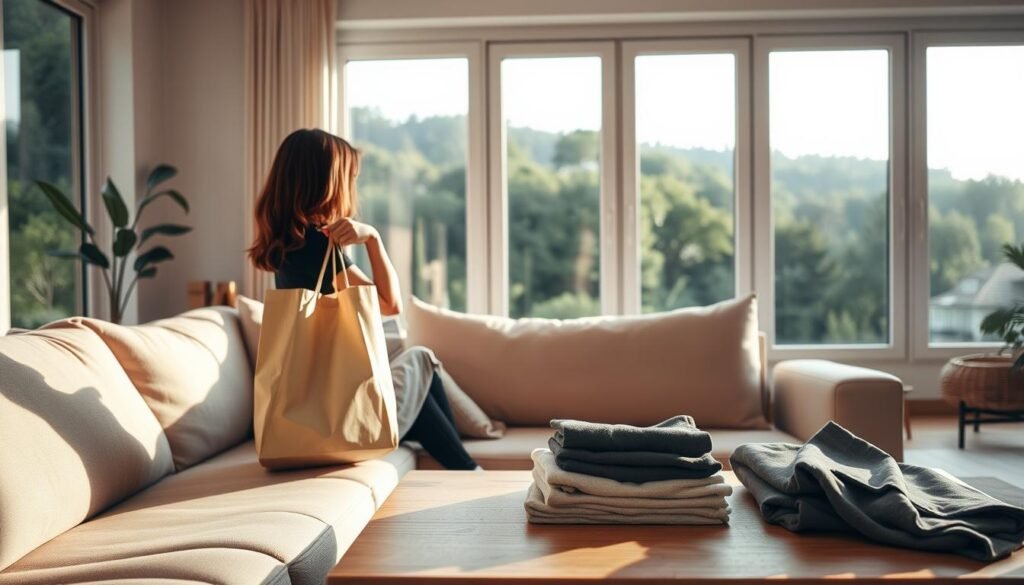
How often do you buy clothes you never wear? The fashion industry produces 92 million tons of waste yearly, with 85% ending up in landfills. Shifting to intentional shopping breaks this cycle. Start by researching brands’ labor practices and material sources before purchasing. Apps like Good On You simplify this process, rating companies on ethics and sustainability.
Building a Sustainable, Investment-Based Closet
Quality over quantity saves money long-term. A $200 wool coat worn 100 times costs $2 per use—cheaper than five $40 jackets discarded after one season. Patagonia’s Worn Wear program exemplifies this mindset, offering repaired outerwear that lasts decades.
| Fast Fashion Item | Sustainable Alternative | Cost Per Year |
|---|---|---|
| Polyester Blouse | Organic Cotton Shirt | $12 vs. $4 |
| Plastic Shoes | Vegetable-Tanned Leather | $25 vs. $8 |
Budgeting and Smart Buying Decisions
Follow the 30-day rule: Wait a month before buying non-essential items. During this period, 68% of impulse wants fade according to Cornell University research. For essentials, use our Sustainable Fabric Guide to identify durable materials like Tencel or recycled nylon.
Track your most-worn pieces. If black trousers anchor 40% of your outfits, invest in a premium pair from Reformation. Their deadstock fabric collection reduces waste while offering timeless cuts. As designer Eileen Fisher advises:
“Buy less, but better. Let your closet reflect your values, not fleeting trends.”
For seasonal updates, explore our Cost-Per-Wear Calculator. This tool helps prioritize pieces that serve multiple purposes, like Quince’s washable silk tops that work for day-to-night transitions.
Incorporating Seasonal Updates in Your Capsule Wardrobe
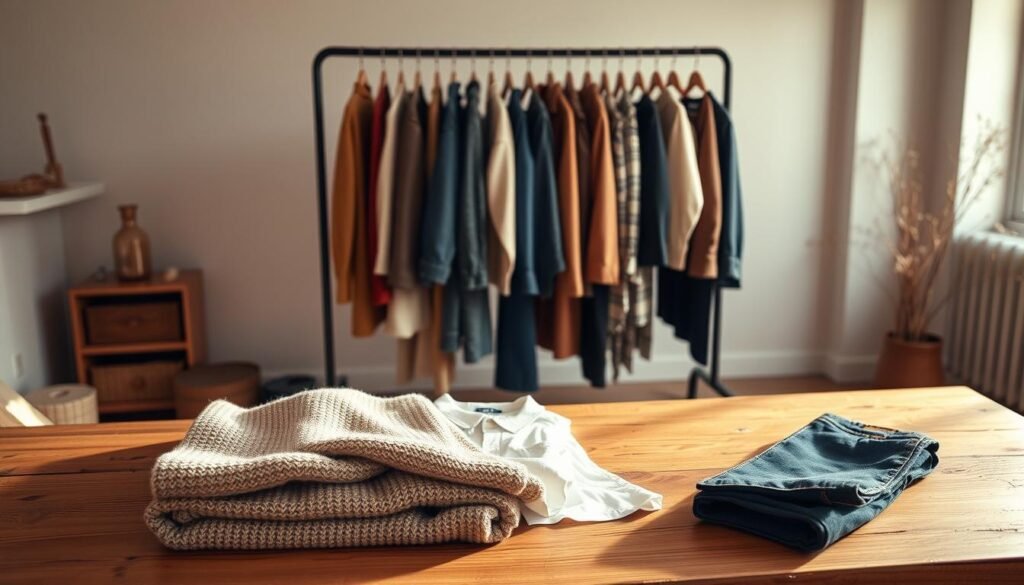
Seasons shift, but your core collection remains—when approached strategically. Three key items can refresh your rotation without clutter.
Adapting to Climate and Trends
Weather changes demand practical adjustments. A 2023 McKinsey report shows 68% of shoppers update their closets for temperature shifts. But trends matter too—softened tailoring and earthy tones dominated recent summer runways.
Choose transitional items that serve multiple looks. A linen-blend shirt works as a beach cover-up or layered under sweaters. Brands like Quince offer washable silk tanks that transition from summer brunches to fall layering.
| Summer Staples | Fall Bridges | Brand Examples |
|---|---|---|
| Lightweight midi dress | Cropped wool cardigan | Reformation |
| Wide-leg linen pants | Leather slide sandals | Cuyana |
Pair summer whites with autumn’s camel tones for cohesive looks. Roll sleeves on chambray shirts when temperatures drop, or add tights to breezy dresses. As Cuyana’s designer notes:
“One great piece should solve three seasonal problems.”
Explore our Summer-to-Fall Transition Guide for exact color pairings. Check out our Seasonal Color Pairing Handbook to blend new accents with existing neutrals effortlessly.
Maintenance Tips for Your Minimalist Wardrobe

Your daily choices shape how your collection ages. Start by rotating items weekly to prevent overuse. Delicate fabrics like silk or cashmere need gentle care—hand wash with cold water and lay flat to dry. For wool blazers, use cedar hangers to maintain shape and repel moths.
Storage matters as much as cleaning. Fold knitwear in acid-free tissue paper to avoid stretching. Vacuum-sealed bags protect winter coats during fall storage, while breathable cotton covers shield summer linens. As one professional organizer notes:
“Treat your closet like an art gallery—every piece deserves preservation.”
Conduct quarterly audits. Ask: Does this still make me feel unstoppable? Donate items that no longer fit your lifestyle. Our closet detox checklist simplifies this process.
| Task | Frequency | Benefit |
|---|---|---|
| Steam wrinkles | Before wear | Maintains fabric integrity |
| Rotate shoes | Monthly | Prevents sole damage |
| Check seams | Seasonally | Extends garment lifespan |
Proper care strengthens your foundation pieces. Spot-clean stains immediately with eco-friendly solutions from our sustainable fabric care guide. For fall transitions, store lightweight layers in clear bins—visible organization prevents duplicates.
Update accessories instead of replacing core items. A leather conditioner revives tired bags, while suede brushes refresh shoes. These small acts keep your foundation fresh for years. Explore our closet organization strategies for advanced techniques that make you feel confident in every choice.
Organizing Your Closet for Maximum Efficiency
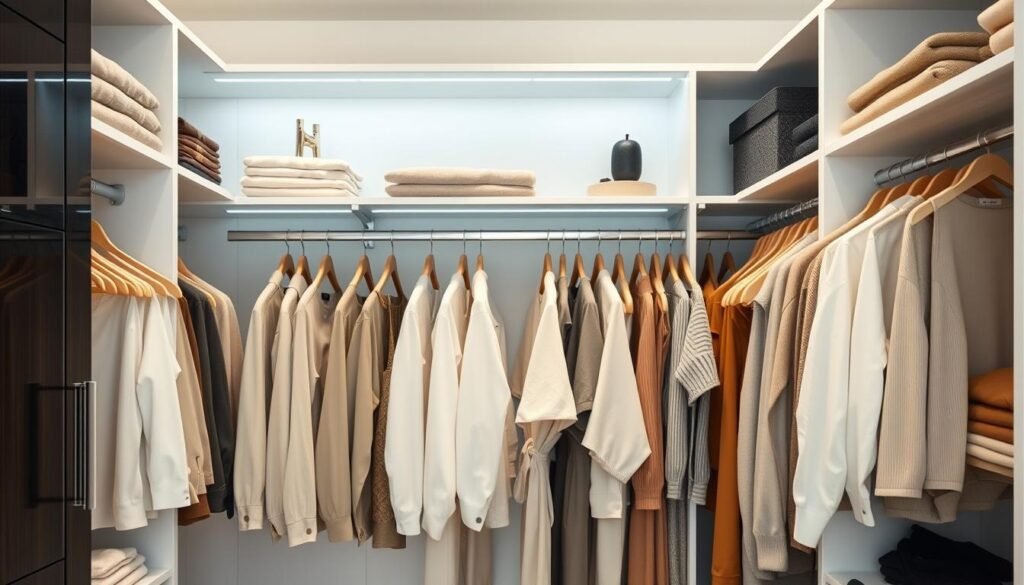
Your closet should mirror your best self—streamlined, intentional, and free of clutter. A well-curated space makes daily choices effortless and keeps your personal style front and center. Start by asking: “Does this item still represent who I am today?” If not, it’s time to let go.
Decluttering and Smart Storage Solutions
Begin with the 12-month rule. Remove anything unworn in the past year—studies show 64% of these pieces make sure your space stays outdated. Sort items into “keep,” “donate,” and “repurpose” piles. For sentimental pieces bought years ago, photograph them before parting ways.
Maximize vertical space with these solutions:
| Storage Tool | Purpose | Brand Example |
|---|---|---|
| Velvet hangers | Prevent slippage | Simple Houseware |
| Clear acrylic bins | Store folded knits | Container Store |
| Over-door racks | Organize accessories | IKEA |
Rotate seasonal items quarterly. Store winter coats in vacuum-sealed bags during summer, swapping them with lightweight layers. As professional organizer Shira Gill advises:
“Edit until every piece sparks joy. Your closet isn’t a museum for years ago versions of you.”
Label shelves using chalkboard tags for quick access. Group similar colors together—this visual system make sure outfits come together faster. For deeper strategies, explore our closet detox checklist and sustainable fabric care guide.
Regular audits keep your personal style sharp. Dedicate 15 minutes monthly to reassess what stays. When every item aligns with your current life, getting dressed becomes a celebration—not a chore.
Styling Your Capsule Wardrobe for Different Occasions

Your favorite pieces should work as hard as you do—transforming seamlessly from boardroom to brunch. Start with a black blazer from Theory, pairing it with cropped trousers for client meetings. Swap to distressed jeans and sneakers for weekend errands. This approach lets you craft 10+ looks without new purchases.
Creating Work and Casual Outfits
Layer strategically. A crisp white shirt tucks into tailored pants for office days, then knots over bike shorts for evening walks. Madewell’s stretch-linen button-down adapts to both scenarios while resisting wrinkles. Follow this formula:
| Work Look | Casual Swap |
|---|---|
| Blazer + pencil skirt | Blazer + denim cutoff shorts |
| Loafers | Slip-on sandals |
Accessories shift the vibe. Add a silk scarf for presentations or a baseball cap for farmers’ markets. As stylist Allison Bornstein advises:
“Three rule: Every top should pair with three bottoms. That’s how you unlock endless combinations.”
Elevating Your Look for Special Events
Your blazer becomes evening-ready with a sequined tank and leather pants. For weddings, layer a satin camisole under a structured jacket—Reformation’s ivory style photographs beautifully. Finish with metallic mules from Sam Edelman.
Discover more formal pairings in our event-ready outfits guide. Remember: A well-cut shirt in luxe fabrics like silk-cotton blends elevates simple looks instantly. Rotate statement jewelry or bold lip colors to keep ensembles fresh.
Inspiration from Fashion Icons and Trendsetters
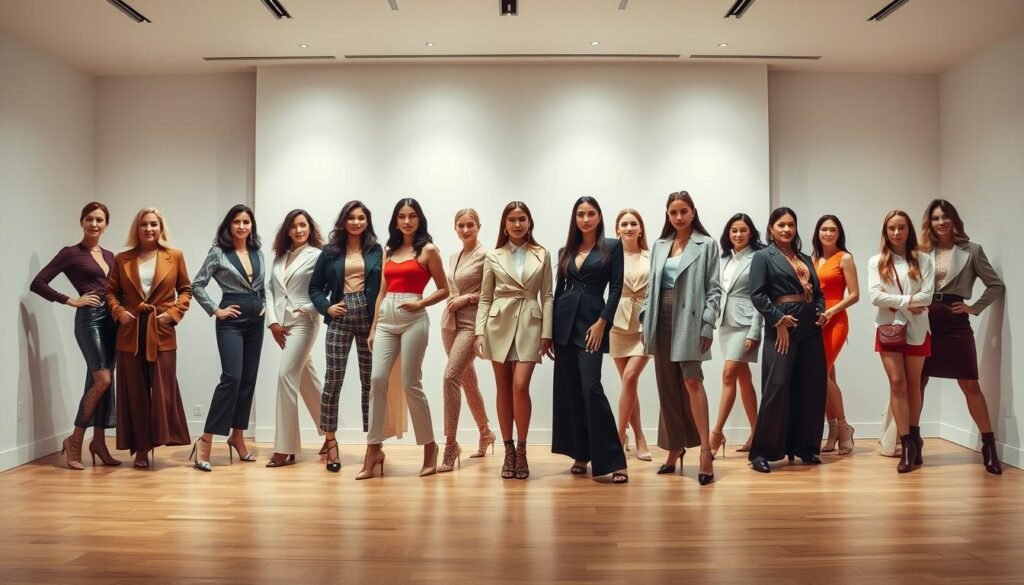
What if your style could borrow wisdom from the world’s most influential designers? Industry leaders like Chloe Harrouche of Loulou Studio prove that minimalism thrives when anchored in purpose. Her collections feature jackets with architectural lines that pair equally with silk skirts or vintage denim—proving restraint fuels creativity.
Lessons from Industry Leaders
Smart shopping starts with studying those who’ve mastered the craft. Harrouche’s approach? “Edit your closet like a gallery—only pieces that spark joy earn a spot.” Her curated list of essentials includes a leather moto jacket and oversized blazer, items she reworks across 30+ outfits annually.
Iconic stylists emphasize strategic investments. For example:
- A structured blazer from Toteme works for Zoom calls and weekend markets
- Khaite’s tailored trench coat transitions from rainwear to evening layers
- Vintage Levi’s trucker jackets add edge to minimalist looks
Build your own signature list using this framework:
| Item | Versatility Score | Brand Inspiration |
|---|---|---|
| Leather Biker Jacket | 9/10 | AllSaints |
| Oversized Blazer | 8/10 | Arket |
| Denim Shacket | 7/10 | Madewell |
Adapt these principles by starting with one hero piece. Pair a cropped jacket with wide-leg trousers for work, then switch to leather leggings for dinners. Explore our interview with trendsetters to discover how they blend practicality with personality.
Remember: Great style isn’t about imitation—it’s about evolution. Let these icons guide your shopping choices, not dictate them. For more inspiration, dive into our definitive guide to leather jackets or profile on sustainable designers reshaping the industry.
Conclusion
Simplifying your closet creates space for confidence. A curated collection of 10 versatile items cuts decision stress while aligning with eco-conscious values. Focus on durable fabrics like organic cotton or wool-blend coats that transition effortlessly from workdays to weekends.
Timeless quality beats fleeting trends. A tailored trench layer pairs equally with silk dresses and relaxed denim, proving adaptability matters. Studies show streamlined closets reduce textile waste by 83% compared to conventional wardrobes.
Maintaining this approach requires intentional choices. Rotate seasonal accents like lightweight scarves or chunky boots while keeping core pieces neutral. Explore our Sustainable Fabric Care Handbook to extend garment lifecycles.
Ready to refine your strategy? Dive into our guides on year-round layering and investment shopping. Subscribe for weekly tips on building looks that evolve with your life—without clutter.

